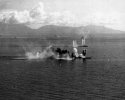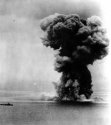Miragedriver
Brigadier

D Day plus one. On the shingle of Omaha Beach Dog White sector, at Saint-Laurent sur Mer, Normandy.
"I managed to find one reference to this photo on a French web site and I sent a scan of it to Joseph Balkoski author of 'Omaha Beach: D-Day, June 6, 1944'. He concurred on the location and possible date. What I find interesting is the fact that there are so few people around. Must have been right before the big surge of troops onto shore.
This photo would be the spot that General Cota rallied the troops and led the attack off the beach. At 07:50, C/116 led the charge off of Dog White, between WN-68 and WN-70, by forcing gaps in the wire with a Bangalore torpedo and wire cutters. 20 minutes later, the 5th Rangers joined the advance, and blew more openings. The command party established themselves at the top of the bluff, and elements of G/116 and H/116 joined them, having earlier moved laterally along the beach, and now the narrow front had widened to the east. Before 09:00, small parties from F/116 and B/116 reached the crests just east of Dog White. The right flank of this penetration was covered by the survivors of the 2nd Rangers’ A and B companies, who had independently fought their way to the top between 08:00 and 08:30. They took WN-70 (already heavily damaged by naval shells), and joined the 5th Rangers for the move inland. By 09:00 more than 600 American troops, in groups ranging from company sized to just a few men, had reached the top of the bluff opposite Dog White and were advancing inland
This picture is from a 2 ½ by 2 ½ inch black and white negative most likely taken by an Army Signal Corps Photographer. Apparently the photographer liked it enough to bring it home. I purchased it a couple of years ago."
(Additional notes from 'PhotosNormandie' - "Des marins américains se tiennent sur des galets devant un muret, probablement à Dog White, vers le 7 juin 1944.
A Omaha, les 6 th et 7th U.S. Naval Beach Battalion (NBB) avec les 5th et 6th Engineer Special Brigade (ESB) sous les ordres du Brigadier General William M. Hoge formaient la Task Force 124.2 'Shore Party'.")
(Image and Caption supplied by and Colorized by Dave Ford from Ohio, USA)
Back to bottling my Grenache



















